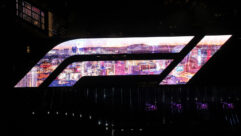Inside Las Vegas’ CityCenter
Las Vegas’ CityCenter is big. Really big. From room automation to digital signage, AV integrators left nothing in their toolbox when building CityCenter’s massive AV systems.
In a city that refuses to take “slow” for an answer, the $11 billion CityCenter stands as a monument to Las Vegas’ unceasing drive to continuously reinvent itself. The Aria, Mandarin Oriental, and Vdara hotels and resorts join luxury residential condominiums and a half-million square feet of retail and entertainment spaces covering 67 acres in the heart of Las Vegas’ strip. A joint venture between MGM Mirage and Dubai World subsidiary Infinity World Development Corp., it’s also one of the largest sustainable developments in the world, with six LEED Gold certifications from the U.S. Green Building Council.
Its also an AV and building automation marvel.
The hotels were a massive undertaking. At the 61-story Aria Resort & Casino, architect Pelli Clarke Pelli designed 4,004 high-tech guestrooms, including 568 suites, ranging from 520 to 2,000 square feet each. The penthouse sprawls over 8,000 square feet. Kohn Pedersen Fox, architects for the Mandarin Oriental, designed a 47-story edifice with 392 rooms and luxurious suites starting at 500 square feet, as well as 225 luxury condominiums that occupy the top floors.
With guests and residents expecting a high degree of amenities, managing the technology posed a challenge. When it opened, CityCenter became the largest deployment of Control4 Suite Systems to date, giving operators unprecedented control of the facility’s energy usage. CityCenter’s room automation systems, which let users control virtually every part of their environment and interact with entertainment and hotel services, are built on what was launched as a more affordable wireless home automation platform but has grown to suit many markets.
Control4 supplied much of the technology products and project management for automating hotel rooms in the Aria and Mandarin hotels. PMK Consultants handled much of the common areas’ systems design and installation, supported by AV systems contractors from AVI-SPL, Ford AV, and Technology West Group.
“What set this project apart was its immense scale,” says Paul Williams, Control4’s vice president of global hospitality services and the project coordinator for the hotels’ in-room systems. “It was an order of magnitude larger than anything that came before it.”
Each tier of rooms needed a “door to drapes” solution. Control4 systems automate various functions that are common to all rooms, including RFID-enabled door locks, Control4 lighting, and MechoShade motorized blinds and drapes. Each room is programmed for various basic scenes, including the welcoming scene that unlocks the door with a wave of the key card, turns on lights, music, and video screens, and opens the blinds or drapes.
Once inside, precise control over these and the HVAC system is handled through an Ethernet-based 7-inch Control4 touchscreen that sits bedside. (The same functionality is also available through the on-screen interface on the Philips 42HFL5860D/27 42-inch LCD TV using the remote control.)
Information about a room’s status is integrated with the hotel’s Micros Opera property management system. For instance, one hour after a guest checks out, the hotel’s server informs the Control4 server, which directs the now-vacant room’s blinds to close and HVAC to turn itself down. When it comes to the in-room minibar, a ZigBee-enabled Bartech system senses when an item has been removed for more than one minute and then informs the hotel’s billing server that the guest has bought the item.
“This is basically an extreme network,” Williams says. “The hotel rooms are each on their own separate virtual LANs, tied into a master LAN and the hotel servers.” Williams estimates that the reduction in cabling from the use of wireless systems cut as much as $1 million from the project’s cost.
Still, the wiring infrastructure to support all of that wireless operation is substantial. Each room is connected to the network by two-pair fiber cabling, then by Cat-6 cable point-to-point within the room. Also riding on the wire is the HotSOS job-ticketing system, which generates work orders for each room. The Mandarin’s security department is also notified if a guest room’s door is open for more than 15 minutes.
The only way to efficiently program such a large number of rooms was to create templates for various room types, then update the control systems via the network. That includes the Aria’s Sky Villas, which range from 2,000 to 7,000 square feet. The largest has 24 zones of audio and up to 16 LCD and plasma TVs, including a giant 65-inch Panasonic plasma—all in a penthouse with 30 feet of windows facing the Strip.
“These are more like high-end homes,” says Williams. In addition to HD-over-IP video-on-demand, guests in Sky Villa rooms can get content via DirecTV, requiring Sony CAV-CVS12ES HD video switches and AMX Modula audio matrix switchers in each villa.
Audio permeates each villa over a distributed system of JBL Pro Control 328C and 24C ceiling-mounted speakers, powered by Control4’s 16-channel amplifiers. Guests can customize the system by plugging their own devices into a GuestLink PW1A-GL2 connectivity panel that offers a proprietary Apple iPod/iPhone interface, HDMI, VGA, and S-Video inputs. The expanded complexity of the villas required extra Cat-6 and fiber cabling, which terminates to tech closets that each serve up to three villas.
Perhaps the biggest challenge in integrating rooms at CityCenter was change. For instance, the 7-inch Control4 touchscreen in every room didn’t even exist more than three years ago when Control4 first bid on the project. It and other products had to be added or updated over time as change orders. Williams says that it became crucial to stay in touch with other vendors to accommodate changes in any of their products that interacted with Control4’s systems.
“Until about five years or so ago, the hotel tended to be secondary to the casino in property management thinking,” Williams says. “But in the last few years, the guest experience has become a more important part of the revenue equation. This has been a great example of how systems can help them accomplish that.”
Big City, Big AV
Of course, guests at CityCenter will find prominent AV systems throughout the massive complex, such as a digital signage network of more than 95 NEC MultiSync LCDs ranging in size from from 32 to 46 inches. The digital signs are used for wayfinding in the Aria’s convention facility, the Crystals retail promenade, and other locations. Where the NEC displays are combined with touch overlays from the Canyvs division of Richardson Electronics, theyre interactive.
Describing what is one of the largest consolidated AV system designs in history, Darren Smith, who worked for PMK Consultants on the project, estimates the cost at over $100 million for the PMK-designed portion alone. That includes 60 venues, 750 BSS BLU London networked DSPs, 700 networked Crown amplifiers, and more than 5,300 JBL Pro Control Series loudspeakers.
The audio design in the convention center, for example, is very granular. It’s divided into nearly 1,000 zones, each with JBL Pro Control 312CS and 322CT speakers on their own 8-ohm amp channel and DSP connection. “You can literally EQ and time-align any one speaker out of the 900 or so in the four ballrooms,” Smith explains. “It’s not a function they’ll use every day, but if there is a need to isolate the sound over a particular table, they can do it from the head end.”
The distributed audio is controlled over Harman’s HiQNet protocol. “We required complete monitoring and control of everything on the HiQ network from London to Crown amplifiers to Vertec to Soundcraft Studer desks to dbx drive racks, as well as several Lab.gruppen amps,” says Smith. “Essentially, we needed to be able to grab a specific venue and easily tweak and monitor every aspect of the audio on the fly.”
Smith explains that the facility is so large that granular monitoring and troubleshooting was a top priority. PMK Consultants designed separate fiber backbones for CobraNet primary and secondary, control, and BluLink communications. In fact, there’s a CobraNet link to the corporate network in order to deliver a single CobraNet channel to every elevator machine room and provide source audio to elevator cabs.“To be able to pull a CobraNet or BluLink channel from the spa or other location for a special event and pipe it into a restaurant, for example, is a beautifully powerful thing that previously required tie lines everywhere,” Smith says.
HD video is distributed throughout the complex, including to the huge sports book, where more than 100 video displays present up to 16 video streams and include multiple graphical tickers. The displays include Barco NX-4 LED panels and the latest generation of Panasonic 103-inch and 65-inch plasma panels, each with a Miranda Technologies Kaleido X16 multiviewer assigned to it. A variety of Miranda signal management products, including a 576×576 core router handle more than 140 video sources in the sports book, and additional I/Os handle special event feeds to and from other areas of the property, including the convention center
“The biggest battle was getting 100 percent HD signal throughout, distributing HDMI sources with HDCP encryption,” says Smith. The solution was to back off those ambitions a bit. Instead, they used HD-SDI, a broadcast-type of approach that Smith says was “a blessing in disguise” in that it also reduced the amount of cabling through the use of coaxial cable. “It also let us use more broadcast-grade products like the Miranda routers,” he says.
The sports book is designed less in the control room style found in many venues and more like a sports bar. Sight lines were important, but so was keeping the space as intimate as possible. That was accomplished by using the routers and multi-image processors to enable the 103-inch displays to be broken down into four PIPs with Extron ISS 506 six-input seamless switchers to scale auxiliary inputs.
And reflecting Las Vegas’ singularity, provisions were even made in case a high roller requests that video from an iPod be scaled and displayed on the largest displays.
“That’s a $10,000 switcher dedicated to something that might happen once every 10 years,” Smith marvels. “That’s Las Vegas.”










